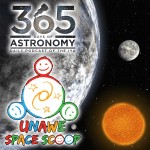Podcaster: Richard Drumm
 Title: Space Scoop: The Oxygen Illusion
Title: Space Scoop: The Oxygen Illusion
Organization: 365 Days Of Astronomy
Link : astrosphere.org ; http://unawe.org/kids/unawe1542/
Description: Space scoop, news for children.
Bio: Richard Drumm is President of the Charlottesville Astronomical Society and President of 3D – Drumm Digital Design, a video production company with clients such as Kodak, Xerox and GlaxoSmithKline Pharmaceuticals. He was an observer with the UVa Parallax Program at McCormick Observatory in 1981 & 1982. He has found that his greatest passion in life is public outreach astronomy and he pursues it at every opportunity.
Today’s sponsor: This episode of “365 Days of Astronomy” is sponsored by — no one. We still need sponsors for many days in 2015, so please consider sponsoring a day or two. Just click on the “Donate” button on the lower left side of this webpage, or contact us at signup@365daysofastronomy.org.
Transcript:
This is 365 Days of Astronomy. Today we bring you a new episode in our Space Scoop series. This show is produced in collaboration with Universe Awareness, a program that strives to inspire every child with our wonderful cosmos.
Today’s story is: The Oxygen Illusion
One of the most common questions about the Universe is “Does alien life exist?” Well the answer is: we don’t know. However, in the last 25 years almost 2,000 planets have been discovered orbiting distant stars. This has brought us much closer to an answer, but not all the way.
These distant worlds are called exoplanets. Mostly they are all so far away that they appear much too small and dim to photograph or detect directly. Yet by using some very clever techniques (specifically spectroscopy), astronomers can still gather lots of information about these alien worlds.
One important piece of information we can extract is what their atmospheres are made of. Earth’s atmosphere contains 78.09% nitrogen, 20.95% oxygen, 0.93% argon and 0.039% carbon dioxide. There are tiny traces of other gasses, neon, helium, methane, krypton and hydrogen, and various amounts of water vapor, which averages 0.4% overall.
This oxygen we have here to breathe is created by plants through photosynthesis.
Plants use carbon dioxide from the atmosphere (along with water and sunlight) to produce oxygen. As you can see from the percentage numbers that I mentioned, there isn’t a large percentage of carbon dioxide, around .04%, but even so it plays a huge role in global warming.
And because plant life is responsible for the large amount of oxygen in Earth’s atmosphere, the existence of oxygen on other planets was thought to be a definite sign of alien life. But now, scientists in Japan have suggested that large amounts of oxygen can also form on planets without life.
They showed that so-called abiotic oxygen can be produced in large amounts from a photocatalytic reaction of water in the presence of near ultraviolet light and a naturally occurring chemical compound called titanium dioxide.
This is the same substance that’s used in some sunscreens. What’s more, this substance is known to be abundant on the surfaces of rocky planets, meteorites, and on our own Moon.
So, although oxygen on distant worlds could still be a sign of life, we now need to find another way to examine exoplanetary atmospheres before we can be definitively sure alien plant life is there.
This sunscreen component may unfortunately act as a source of false signs of life when examining exoplanets in the habitable zone of their stars.
Hey, Here’s A Cool Fact:
In this process, 2 molecules of water, H2O, become one oxygen molecule, O2, and 2 molecules of hydrogen, H2. Hydrogen, being very low density, rises to the top of the atmosphere and is likely blown away by the solar wind, leaving the heavier oxygen behind.
So even though this process could create false positives in the search for alien life, it could also make an otherwise uninhabitable planet habitable for us humans should we need to relocate our species to another star system.
We’d better bring some potatoes to plant…
End of podcast:
365 Days of Astronomy
=====================
The 365 Days of Astronomy Podcast is produced by NUCLIO. Audio post-production by Richard Drumm. Bandwidth donated by libsyn.com and wizzard media. You may reproduce and distribute this audio for non-commercial purposes. Please consider supporting the podcast with a few dollars (or Euros!). Visit us on the web at 365DaysOfAstronomy.org or email us at info@365DaysOfAstronomy.org. This year we celebrate cosmic light as light is our info messenger in the universe. Join us and share your story to celebrate the International Year of Light. Until tomorrow! Goodbye!

